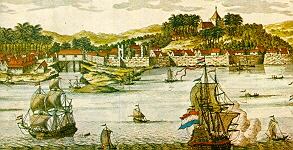


The history of Malacca is largely the story of the city for which it is named, and the story of the city of Malacca begins with the fascinating and partly legendary tale of the Hindu prince Parameswara.

The Malay Annals relate that Parameswara was a fourteenth-century Palembang prince who, fleeing from a Javanese enemy, escaped to the island of Temasik (present-day Singapore) and quickly established himself as its king. Shortly afterward, however, Parameswara was driven out of Temasik by an invasion by the Siamese, and with a small band of followers set out along the west coast of the Malay peninsula in search of a new refuge. The refugees settled first at Muar, Johor, but they were quickly driven away by a vast and implacable horde of monitor lizards; the second spot chosen seemed equally unfavorable, as the fortress that the refugees began to build fell to ruins immediately. Parameswara moved on. Soon afterward, during a hunt near the mouth of a river called Bertam, he saw a white mouse-deer or pelanduk kick one of his hunting dogs. So impressed was he by the mouse-deer's brave gesture that he decided immediately to build a city on the spot. He asked one of his servants the name of the tree under which he was resting and, being informed that the tree was called a Malaka, gave that name to the city. The year was 1400.

Although its origin is as much romance as history, the fact is that Parameswara's new city was situated at a point of tremendous strategic importance. Midway along the straits that linked China to India and the Near East, Malacca was perfectly positioned as a center for maritime trade. The city grew rapidly, and within fifty years it had become a wealthy and powerful hub of international commerce, with a population of over 50,000. It was during this period of Malacca's history that Islam was introduced to the Malay world, arriving along with Gujarati traders from western India. By the first decade of the sixteenth century Malacca was a bustling, cosmopolitan port, attracting hundreds of ships each year. The city was known worldwide as a center for the trade of silk and porcelain from China; textiles from Gujarat and Coromandel in India; camphor from Borneo; sandalwood from Timor; nutmeg, mace, and cloves from the Moluccas, gold and pepper from Sumatra; and tin from western Malaya.

Unfortunately, this fame arrived at just the moment when Europe began to extend its power into the East, and Malacca was one of the very first cities to attract its covetous eye. The Portuguese under the command of Afonso de Albuquerque arrived first, taking the city after a sustained bombardment in 1511. The Sultan Mahmud fled to Johor, from whence the Malays counterattacked the Portuguese repeatedly though without success. One reason for the strength of the Portuguese defence was the construction of the massive fortification of A Famosa or Porta De Santiago, only a small portion of which survives today.
A Famosa ensured Portuguese control of the city for the next one hundred and fifty years, until, in 1641, the Dutch after an eight-month siege and a fierce battle. Malacca was captured, but it lay in almost complete ruin. Over the next century and a half, the Dutch rebuilt the city and occupied it largely as a military base, using its strategic location to control the Straits of Malacca. In 1795, when the Netherlands was captured by French Revolutionary armies, Malacca was handed over to the British by the Dutch to avoid capture by the French. Although they returned the city to the Dutch in 1808, it was soon given over to the British once again in a trade for Bencoleen, Sumatra. From 1826, the English East India Company in Calcutta ruled the city, although it experienced Japanese occupation from 1942 to 1945. Independence did not arrive until 1957, when anti-colonial sentiment culminated in a proclamation of independence by His Highness Tunku Abdul Rahman Putra Al-Haj, Malaysia's first Prime Minister
.

Chronology of Events
1400
- Parameswara, Hindu prince from Palembang flees Temasik ancient Singapore and founds Malacca.1403
- The first official Chinese trade envoy lead by Admiral Yin Ching arrive in Malacca.1409
- - Admiral Cheng Ho , Commander of the Chinese Imperial fleet, arrives in Malacca on the first of his seven voyages to the Indian Ocean.1411
- Parameswara journeys to China with an entourage of 540 and meets the Ming Emperor Yung Lo.1414
- Parameswara marries a princess from Pasai (Indonesia) and embraces Islam and changes his name to Raja Iskandar Shah.1424
- Sri Maharaja, Parameswara's son, becomes Sultan. He converts to Islam and takes the title Muhammad Shah.1444
- Sultan Muhammad Shah is succeeded by his youngest son Raja Ibrahim on his death. A year late Raja Ibrahim was murdered and buried with the title Sultan Abu Syahid1446
- Raja Kassim ascended the throne with the title Sultan Muzaffar Shah and declared Islam as the state religion. Under his rule Malacca prospers.1447
- First attack from Siam. Later they were defeated in battle near Muar.1456
- Tun Perak becomes Bendahara , Prime Minister with the title Bendahara Paduka Raja. Served under four Sultans, he is responsible for Malacca's rise to power in maritime Southeast Asia.1458
- Sultan Mansur Shah succeeds Sultan Muzaffar Shah. Tun Perpateh Puteh envoy to China brings the Chinese Princess Hang Li Po as a wife for the Sultan.1477
- Sultan Mansur Shah dies. He is succeeded by his 15 year old son Alauddin Riayat Shah .1488
- Sultan Alauddin is poisoned. Sultan Mahmud Shah a cruel and tyrannical ruler succeeds him.1498
- Tun Perak dies.
1500
- Tun Mutahir replaces Tun Perak as Bendahara with the title Bendahara Seri Maharaja. He became the grandest and most powerful of all the Bendaharas.1509
- The first Royal Portuguese trading expedition commanded by Diego Lopez de Sequiera with a fleet of 18 ships arrives in Malacca. The locals called them `Benggali Putih'. A misunderstanding with the Malays took place and they were attacked but escape leaving behind twenty men as prisoners.1510
- Bendahara Tun Mutahir allegedly plots to assassinate the Sultan. Sultan Mahmud Shah executes him and his entire family. Sultans Ahmad Shah succeeded the throne temporary from his father Sultan Mahmud Shah.1511
- Alfonso d' Albuquerque and his Portuguese fleet attack Malacca on the 10 August 1511 and built - A Famosa . Malacca passes into colonial hands for four and a half centuries.1513
- Patih Unus from Java, a Javanese warrior attacks Malacca with 5000 men and 100 ships.1518/1519
- Sultan Mahmud Shah orders his subjects to built high walls around Malacca within three months.1525
- Laksamana Hang Nadim besiege the A Famosa fortress. Food rationing from Goa is carried out.1545
- Saint Francis Xavier visits Malacca on the first of his five sojourn in the city. Malacca was used as his base in the East and from here he attemps to get permission to travel to China.1548
- The first school in Malacca, St Paul's College is established by Saint Francis Xavier for the Portuguese Catholics and newly converted locals.1551
- The combined army of Johor, Japara and Perak besiege Malacca city for three months.1553
- Saint Francis Xavier dies from fever on the Island of Sancian near Canton, China. His body is buried in St. Paul's Church for nine months then transferred to Goa, India.1568
- Johor helps the Portuguese to fight off the Achehnese who terrorize the Malacca Straits for sixty years.1582
- The Portuguese help Johor ward off another Achehnese attack, and Sultan Abdul Jalil Riayat Shah of Johor the first of the former Malay royal house to visit Malacca.1587
- Johor launch a huge land and sea attack on the Portuguese who are saved only by reinforcements from Goa.1588
- Ralph Ritch the first British to visit Malacca.1597
- The Dutch attack Malacca for the first time.
1606
- The Dutch under Admiral Matelieff de Jonge, teams up with the Sultan of Johor and attack Malacca. After a three months seige the Portuguese survive the attack when troops from Goa arrive.1615/1616
- The Achehnese attack Malacca.1628/1629
- Achehnese captured Malacca for eight months before the Portuguese recapture it again.1636
- The Dutch destroyed Portuguese ships at the Malacca harbor.1641
- Malacca fell to the Dutch on the 14 January 1641. The Portuguese Governor, Manuel de Souza Couthinho surrenders the city to Captain Minne Williemson Kaartokoe.1645
- The Cheng Hoon Teng is founded by Kapitan Lee Wei King. It is the oldest functioning Chinese temple in Malaysia today.1650
- The Stadthuys the Dutch administrative centre and home of the Governor is built.
1710
- St. Peter's Church, the oldest functioning Christian church in Malaysia, is built after the Dutch restore freedom of religion to the Catholics.1753
- Christ Church, built next to the Stadhuys in the Town Square, is completed after twelve years.1756
- The Bugis under the command of Daing Kamboja attacks Malacca.1784
- Raja Haji tries to capture Malacca but is killed in battle at Teluk Ketapang.1795
- The English East India Company takes over Malacca temporary during the Napoleonic wars.
1807
- Under William Farquar, the English begin demolishing A Formosa fort and transfer the city's population to Penang. The cost for demolishing the fort was 70,000 pounds.1808
- Sir Stamford Raffles arrives in Malacca and on his recommendation the city was saved from destruction and the plan to evacuate was abandoned with the approval of Lord Minto.1818
- Malacca is restored to the Dutch under the Treaty of Vienna after the Napoleonic Wars.1819
- Sultan Husin Mohamad Shah hands over Singapore to Sir Stamford Raffles of the East India Company. His grave is located in the grounds of Tranquerah Mosque.1824
- The Anglo Dutch Treaty or the Treaty of London was made between the Dutch and the British. The British gives Bencoolen, in Sumatra to the Dutch and Malacca to the English.1826
- Malacca,Penang and Singapore are incorparated as the Straits Settlements of the India government under the British.1867
- The Straits Settlements become a Crown Colony under the Colonial Office in London.1895
- The first rubber trees were planted by Tan Chay Yan at Bukit Lintang, Malacca.1901
- The Queen Victoria Fountain made of English marble is erected to commemorate the Queen's Diamond Jubilee (1837-1897).1941 - 1945
- The Second World War
1942
- Malacca is occupied by the Japanese.1945
- Malacca is restored to the British after the Japanese surrender in Singapore.1948
- The Communist controls Malaya for 14 days. The British declare a state of "Emergency" which lasted for twelve years against the Communist Terrorists.1956
- Tunku Abdul Rahman, Malaysia's first Prime Minister, announces the news of impending indepandence to 50,000 people gathered at the Padang Pahlawan, Bandar Hilir, Malacca on his arrival from London.1957
- Malaysia gains "Merdeka" independence on the 31 Agugust 1957 from the British.1963
- Formation of Malaysia.with Malacca, Singapore, Sabah and Sarawak forging a new nation.1989
- Proclaimation of Malacca as a Historical City on the 15 April, 1989.



